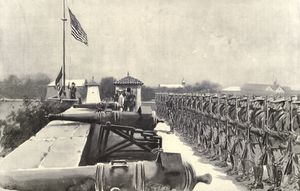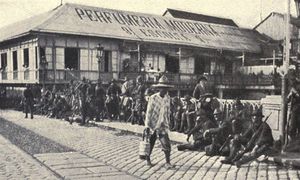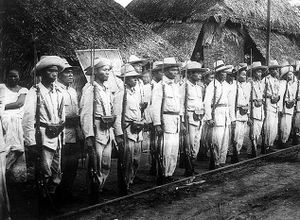معركة مانيلا (1898)
| Battle of Manila | |||||||
|---|---|---|---|---|---|---|---|
| جزء من the Philippine Revolution and Spanish–American War | |||||||
 "Raising the American flag over Fort Santiago, Manila, on the evening of August 13, 1898." drawing from Harper's Pictorial History of the War with Spain. | |||||||
| |||||||
| المتحاربون | |||||||
|
|
| ||||||
| القادة والزعماء | |||||||
|
|
| ||||||
| القوى | |||||||
|
|
| ||||||
| الضحايا والخسائر | |||||||
| 6 killed (United States) | 49 killed, 1 fort | ||||||
قالب:Campaignbox Spanish-American War: Pacific

The Battle of Manila (Filipino: Labanan sa Maynila; إسپانية: Batalla de Manila), sometimes called the Mock Battle of Manila,[1] was a land engagement which took place in Manila on August 13, 1898, at the end of the Spanish–American War, four months after the decisive victory by Commodore Dewey's Asiatic Squadron at the Battle of Manila Bay. The belligerents were Spanish forces led by Governor-General of the Philippines Fermín Jáudenes, and American forces led by United States Army Brigadier General Wesley Merritt and United States Navy Commodore George Dewey. American forces were supported by units of the Philippine Revolutionary Army, led by Emilio Aguinaldo.
The battle is sometimes referred to as the "Mock Battle of Manila"[1] because the local Spanish and American generals, who were legally still at war, secretly and jointly planned the battle to transfer control of the city center from the Spanish to the Americans while keeping the Philippine Revolutionary Army, led by Emilio Aguinaldo, out of the city center.[2]
The battle left American forces in control of Intramuros, the center of Manila, surrounded by Philippine revolutionary forces, creating the conditions for the Battle of Manila of 1899 and the start of the Philippine–American War.
Background
جزء من سلسلة عن |
|---|
| تاريخ الفلپين |
| خط زمني |
| الآثار |
After the American victory in Manila Bay on May 1, 1898, the United States Navy, under Admiral George Dewey, blockaded the city of Manila and waited for land forces to arrive. The United States organized the Eighth Army Corps, dubbed the Philippine Expeditionary Force, under the command of Major General Wesley Merritt.[3] On May 16, the vanguard of the force left San Francisco under the command of Brigadier General Thomas M. Anderson.[4] Merritt, on the same day, asked for information concerning the strength of the Spanish in the Philippines. The American consul in Hong Kong gave the information needed: 21,000 men including 4,000 Filipinos, all except 1,000 of them in Manila.[5] Dewey, however, sent more accurate information: around 40,000 troops including around 16,000 Filipinos, about 15,000 were situated in Manila, and nine artillery guns in Manila.[5] By mid-June, some 40,000 Filipino revolutionaries under General Antonio Luna had dug fourteen miles of trenches around Manila. Filipino revolutionaries, seizing control of Manila's only pumping station, cut off the water supply to the city.[6]
See also
References
- ^ أ ب "The evolution of Manila". Presidential Library and Museum. Government of the Republic of the Philippines. Archived from the original on 14 September 2015. Retrieved 24 September 2015.
{{cite web}}: Unknown parameter|deadurl=ignored (|url-status=suggested) (help) - ^ Agoncillo 1990, pp. 194–195.
- ^ Wolff 2006, p. 92.
- ^ Wolff 2006, p. 95.
- ^ أ ب Agoncillo 1960, pp. 169–170.
- ^ Karnow 1990, p. 115.
Bibliography
- Agoncillo, Teodoro A. (1960), Malolos: The Crisis of the Republic, Quezon City: University of the Philippines, OCLC 2163102
- Agoncillo, Teodoro A. (1990), History of the Filipino People, Garotech Publishing, ISBN 978-971-8711-06-4, https://books.google.com/books?id=KjxFOQAACAAJ
- Blanchard, William H. (1996), Neocolonialism American Style, 1960–2000 (illustrated ed.), Greenwood Publishing Group, ISBN 978-0-313-30013-4, https://books.google.com/?id=d42R23Jq6SMC
- Halstead, Murat (1898), "Chapter X. Official History of the Conquest of Manila", The Story of the Philippines and Our New Possessions, Including the Ladrones, Hawaii, Cuba and Porto Rico, pp. 95–110, http://www.gutenberg.org/catalog/world/readfile?pageno=95&fk_files=58428
- Karnow, Stanley (1990), In Our Image: America's Empire in the Philippines, Random House, Inc., ISBN 978-0-345-32816-8, https://books.google.com/books?id=z9aC90HHTy8C
- Sweetman, Jack (2002), American Naval History: An Illustrated Chronology of the U.S. Navy and Marine Corps, 1775–present, Naval Institute Press, ISBN 978-1-55750-867-6, https://books.google.com/books?id=fAm1Y6gjYtwC
- Trask, David F. (1996), The War With Spain in 1898, University of Nebraska Press, ISBN 978-0-8032-9429-5, https://books.google.com/books?id=6YtDT1ZQ588C
- Wolff, Leon (2006), Little Brown Brother, Wolff Productions, ISBN 978-1-58288-209-3, https://books.google.com/books?id=hHzvx94oiUgC
للاستزادة
- Freidel, Frank (2002). The Splendid Little War. Short Hills, New Jersey: Burford Books. ISBN 978-1-58080-093-8.
وصلات خارجية
- CS1 errors: unsupported parameter
- Articles containing إسپانية-language text
- Pages using Lang-xx templates
- Portal-inline template with redlinked portals
- Pages with empty portal template
- Philippines articles missing geocoordinate data
- All articles needing coordinates
- Conflicts in 1898
- 1898 in the Philippines
- Battles of the Spanish–American War
- معارك الولايات المتحدة
- History of Manila
- Naval battles of the Spanish–American War
- August 1898 events
- Battles of the Philippine Revolution

